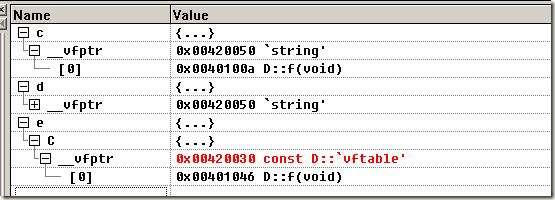C++中多型的實現原理
多型是面向物件的基本特徵之一。而虛擬函式是實現多型的方法。那麼virtual function到底如何實現多型的呢?
1 基類的記憶體分佈情況
請看下面的sample
class A
{
void g(){.....}
};
則sizeof(A)=1;
如果改為如下:
class A
{
public:
virtual void f()
{
......
}
void g(){.....}
}
則sizeof(A)=4! 這是因為在類A中存在virtual function,為了實現多型,每個含有virtual function的類中都隱式包含著一個靜態虛指標vfptr指向該類的靜態虛表vtable, vtable中的表項指向類中的每個virtual function的入口地址
例如 我們declare 一個A型別的object :
A c;
A d;
則編譯後其記憶體分佈如下:
從 vfptr所指向的vtable可以看出,每個virtual function都佔有一個entry,例如本例中的f函式。而g函式因為不是virtual型別,故不在vtable的表項之內。說明:vtab屬於類成員靜態pointer,而vfptr屬於物件pointer
2 繼承類的記憶體分佈狀況
假設程式碼如下:
public B:public A
{
public :
int f() //override virtual function
{
return 3;
}
};
則
A c;
A d;
B e;
編譯後,其記憶體分佈如下:
從中我們可以看出,B型別的物件e有一個vfptr指向vtable address:0x00400030 ,而A型別的物件c和d共同指向類的vtable address:0x00400050a
3 動態繫結過程的實現
我們說多型是在程式進行動態繫結得以實現的,而不是編譯時就確定物件的呼叫方法的靜態繫結。
其過程如下:
程式執行到動態繫結時,通過基類的指標所指向的物件型別,通過vfptr找到其所指向的vtable,然後呼叫其相應的方法,即可實現多型。
例如:
A c;
B e;
A *pc=&e; //設定breakpoint,執行到此處
pc=&c;
此時記憶體中各指標狀況如下:
可以看出,此時pc指向類B的虛表地址,從而呼叫物件e的方法。
繼續執行,當執行至pc=&c時候,此時pc的vptr值為0x00420050,即指向類A的vtable地址,從而呼叫c的方法。
這就是動態繫結!(dynamic binding)或者叫做遲後聯編(lazy compile)。
為了更加透析多型的原理,我們可以debug 程式在runtime時候的物件記憶體分佈情況。
以下面這段簡單的程式為例
// SimpleStack.cpp : Defines the entry point for the console application.//
#include "stdafx.h"class Base
{
public:
int m_data;
staticint m_staticvalue;
Base(int data)
{
m_data=data;
}
virtualvoid DoWork()
{
}
};
class AnotherBase
{
public:
virtualvoid AnotherWork()
{}
};
class DerivedClass:public Base,public AnotherBase
{
public:
DerivedClass(int t_data):Base(t_data)
{}
virtualvoid DoWork()
{
}
virtualvoid AnotherWork()
{
}
};
int Base::m_staticvalue=1;
int main(int argc, char* argv[])
{
DerivedClass b(1);
b.DoWork();
return0;
}
複製程式碼
當程式執行後我們設定很簡單的breakpoint: bp simplestack!derivedclass::dowork. 斷點命中後的call stack如下:
0:000> kb
ChildEBP RetAddr Args to Child
0012ff20 0040102a 00daf6f2 00daf770 7ffd7000 SimpleStack!DerivedClass::DoWork
0012ff80 004012f9 00000001 00420e80 00420dc0 SimpleStack!main+0x2a
0012ffc0 7c817077 00daf6f2 00daf770 7ffd7000 SimpleStack!mainCRTStartup+0xe9
0012fff0 00000000 00401210 00000000 78746341 kernel32!BaseProcessStart+0x23
這時,我們可以看看DerivedClass物件的記憶體內分佈情況:
0:000> dt SimpleStack!DerivedClass 0012ff74
+0x000 __VFN_table : 0x0040c020 //指向虛表的指標1
+0x004 m_data : 1
=0040d030 Base::m_staticvalue : 1 //(類成員)
+0x008 __VFN_table : 0x0040c01c //指向虛表的指標2
可以看到,DerivedClass物件中包含兩個指向虛表的指標,地址分別為0x0040c020 和0x0040c01c 。一個為指向override了BaseClass的方法的虛表,一個指向orverride了AnotherBase方法的虛表。
可以檢視對應虛表中的方法:
0:000> dds 0x0040c01c
0040c01c 00401140 SimpleStack!DerivedClass::AnotherWork
0040c020 00401110 SimpleStack!DerivedClass::DoWork
0040c024 004010e0 SimpleStack!Base::DoWork
0040c028 004011a0 SimpleStack!AnotherBase::AnotherWork
......
通過以上分析,應該可以透析多型的本質了。
這種看記憶體分配方案真的不錯的,^-^
自己也試了一下,雖然常用VC,不過也沒注意過
#include <iostream>
using namespace std;
class base2
{
public:
virtual std::string ff(){return "base2";}
protected:
private:
};
class base
{
public:
virtual std::string f1(){return "base";}
virtual std::string f2(){return "base";}
virtual std::string f3(){return "base";}
protected:
private:
};
class child : public base , public base2
{
public:
virtual std::string f2(){return "child";}
virtual std::string f3(){return "child";}
protected:
private:
};
class grant : public child
{
public:
virtual std::string f3(){return "grant";}
protected:
private:
};
void main()
{
base a;
child b;
grant c;
string sa = a.f1();
string sb = b.f1();
string sc = c.f1();
}
// 記憶體狀態
- a {...}
- __vfptr 0x0042f024 const base::`vftable'
[0x0] 0x00401014 base::f1(void)
[0x1] 0x00401055 base::f2(void)
[0x2] 0x00401032 base::f3(void)
- b {...}
- base {...}
- __vfptr 0x0042f038 const child::`vftable'{for `base'}
[0x0] 0x00401014 base::f1(void)
[0x1] 0x00401050 child::f2(void)
[0x2] 0x0040106e child::f3(void)
- base2 {...}
- __vfptr 0x0042f034 const child::`vftable'{for `base2'}
[0x0] 0x00401023 base2::ff(void)
- c {...}
- child {...}
- base {...}
- __vfptr 0x0042f05c const grant::`vftable'{for `base'}
[0x0] 0x00401014 base::f1(void)
[0x1] 0x00401050 child::f2(void)
[0x2] 0x0040103c grant::f3(void)
- base2 {...}
- __vfptr 0x0042f058 const grant::`vftable'{for `base2'}
[0x0] 0x00401023 base2::ff(void)
